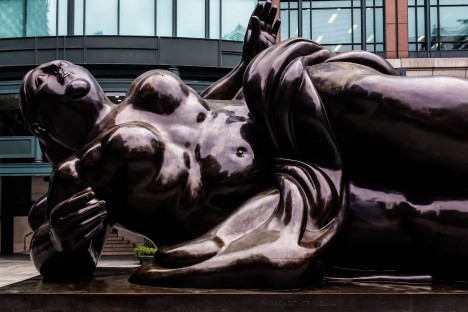Feature
Public Art, Private Amenities
Sara Selwood assesses the state of public art whilst some of it sinks into the Mersey

Fernando Botero, Broadgate Venus, 1989
‘My vision of London is this – I fear the city is drifting towards a “1984-style” dirty, threatening environment with travel almost impossible and with countless people living in the streets – but with a few incongruous splendid set pieces, like escapist islands in a sea of pollution. In short, an environment of private affluence and public squalor, and with no effective means of controlling it.’
Not much has changed since Francis Tibbalds described London in his presidential address to the Royal Town Planning Institute in December 1988. Nor is anything short of a revolution likely to put an end to the root causes of this and other cities’ planning, social problems and diminishing services. Yet we content ourselves with platitudes about the need to set a ‘new agenda’, and some of us rest comfortably in the assurance that the arts are somehow substantially contributing to a better environment.
During the Thatcher years so-called public art has been increasingly conscripted into the service of urban regeneration strategies, so much so that it has come to represent the major growth area of the Arts Industry: colleges train artists for careers in it; numerous agencies exist to promote it; biennial peripatetic national Garden Festivals generate enormous numbers of commissions of it; the Arts Council positively encourages adoption of Percent for Art and independent organisations mount large-scale temporary public art events. It also empowers artists, by virtue of the fact that many public art developments are locked into planning processes; as its creators they are ideally placed to influence developments from their earliest conceptual stages.
It goes without saying that public art is assumed to be a ‘good thing’. The arguments in its favour are familiar enough: it enriches and humanises the built environment, it creates a sense of place, local identity and focus for the community, it makes works by artists easily accessible, it gives pleasure to thousands, it grants artists enormous audiences, creates employment and so on.
But what kind of ‘good’ is public art supposed to do? How does it contribute to the improvement of the inner cities?
The encouragement of public art has largely come about as the result of various government initiatives associated with ‘The Urban Programme’, which was launched in response to the Scarman Report. Commissioned in the wake of the urban violence that marked the early 1980s, the Report recommended that financial investment would bring ‘new life’ to those inner cities suffering from the cumulative effects of deindustrialisation and neglect. The Programme spawned a variety of initiatives whose titles alone summon up a spirit of the Eighties: ‘Urban Development Corporations’, ‘Inner City Task Forces’, ‘Enterprise Zones’ and so on.
The Arts Council, caught up in the momentum, responded with an urban policy for the arts. Its document, ‘An Urban Renaissance’, listed the various contributions the arts could make to inner city initiatives. It deemed the arts capable of regenerating civic and individual pride, attracting business investment, serving as a catalyst for redevelopment and the creation of employment in the cultural and tourism industries – claims which were subsequently substantiated by the Policy Studies Institute’s report on ‘The Economic Importance of the Arts in Britain’.
Public art is at its most conspicuous in Garden Festivals. These were inspired by a West German post-War scheme for the reconstruction of their bombed cities. Following Heseltine’s post-Toxteth riots visit to Liverpool in 1981, the Garden Festival was proposed as a way of stimulating investment in and regeneration of those areas of Britain scarred by the abandonment of manufacturing industries. They were intended to encourage the reclamation of derelict land; secure long-term redevelopment; provide a focus for regional promotion and last but not least celebrate urban renewal. The first Festival was sited in Liverpool in 1984 where, as with subsequent sites at Stoke (1986), Glasgow (1988) and now Gateshead (1990), millions were spent removing and camouflaging industrial debris. Potential developers, tourists and box-office returns are attracted by the generation of fairground-cum-theme park atmospheres, seasoned by the addition of a variety of sculptures.
On the 200 acre Gateshead site, the work of over 60 artists was to be ‘fully integrated’ with all the other entertainment and leisure paraphernalia: fast-food stands, German beer gardens, playpens and mono-rails dressed up to look like caterpillars. The press release set the tone by describing the interests of two particular sculpture commissions - one ‘humorous’, ‘an anarchic and witty play of the equestrian statue’, the other statistical and of local interest: the biggest single work in the biggest exhibition of contemporary art in Britain, Red Army, comprised ‘1,250 red steel figures … fabricated by the Shipbuilder Swan Hunter at their Tyneside yard with material provided by British Steel’.
Public art is also encouraged through ‘Percent for Art’, another scheme designed to stimulate regeneration. Launched by the Arts Council in 1989, it is focused on local authorities and urban development corporations whose responsibilities cross the arts, planning, architecture and economic development. It works by a percentage of the capital costs of buildings or developments being set aside for commissioning new permanent works by artists and craftspeople. At the last count, 55 local planning authorities had committed to encouraging developers to implement the scheme. Percent for Art is still voluntary in this country; in the USA the provision of public art in building development proposals is now mandatory in 21 states and 98 cities.
Given the scale of public subsidy needed to realise these schemes, one wonders about how much benefit they actually accrue. To put it another way, is there a quantifiable functional relationship between the amount pumped into public art in Glasgow (1988 Garden Festival; 1990 European City of Culture) and that city’s social and economic problems?
The usual defence of public art is that it gives pleasure. Isobel Vasseur, art co-ordinator of both the Glasgow and Gateshead festivals, is cited as saying: ‘I think it’s so exciting putting something up that’s going to be seen by such a cross-section of the public. The people who come are relaxed and happy. They’re having a day out.’
Other benefits associated with public art have included its use as a focus for employment and training initiatives. Paul Collard’s controversial, unpublished report on ‘The Arts and Unemployment’, commissioned in 1988 by The Office of Arts and Libraries, indicated that young people involved in MSC art-based projects had a much higher success rate in getting employment after training than those on other schemes. The experience developed their self-confidence and adaptability. Clearly, many public art works had a chicken/egg relationship with MSC schemes: of the land art projects in Northumberland and the Isle of Portland, for example, one wonders which came first, the art or the MSC.
Then, of course, there are the financial benefits: the PSI report makes no specific mention of public art, though it would doubtless classify as fitting into the category of ‘amenity factors’ which, albeit indirectly, influence economic development. ‘The Public Art Report’, published in 1990 by The Public Art Forum (the representative body of public art promoters) is similarly vague. It merely refers to the role artists have to play in economic regeneration.
The value of public art per se, however, radically shifts between the public and private sectors: art commissioned for Garden Festivals appears not to represent an investment. In Liverpool the Council attempted to continue the Festival as a public facility. By all accounts the sculptures are still there but deserted and off-limits. Along with the landscaped dereliction around them they have been left to sink into the Mersey. Significantly the blind auction run by Christies for the Gateshead Festival resulted in virtually no sales of sculpture.
With respect to Percent for Art the situation totally changes. Within that scheme’s terms of reference, art and craft exclusives are used explicity to denote the ‘quality’ of individual developments. In this context art represents a business investment for developers. The County Hall Development Group’s plans illustrate the point precisely: they recently set aside a record £6 million for art and design commissions: ‘Our arts objectives are quite consistent with our commercial aims … not only will they contribute to the quality of the environment, but they will help in attracting tenants and occupiers into the completed development. It is important for developers to have regard for this aspect of any scheme. It is not an added cost, it is an added ingredient in the tenants’ market.’
As one would expect, Lord Palumbo, property developer and Chairman of the Arts Council of Great Britain, avidly supports the scheme; as he says, ‘good design means good business’. Percent for Art also allows the Arts Council to comply with government arts policy in other respects: it represents yet another means whereby responsibility for the public arts can be shifted away from the state: it specifically encourages the private sector simultaneously to assume the mantle of patronage and to raise the profile of art in the public arena.
Faced with the realities of Percent for Art one can only sympathise with Francis Tibbalds’ calls for a new agenda intended to ‘elevate the needs and aspirations of ordinary people above a combination of rampant profiteering … and arrogant professional individualism’. This year’s TSWA was organised to serve precisely the interests of those individual artists whom it parachuted into four cities. The combined power of sponsors, art bureaucrats, local authorities and well-meaning trusts enabled the artists and organisers to pursue expressly their own concerns rather than those of the community. As one of the organisers, James Lingwood, wrote in the catalogue: ‘The directional pull of most community arts has been towards a lowest common denominator … I’m not interested in commissioning projects which have at their base the need not to displease … on the contrary … they have to be prepared to displease.’
One might be forgiven for assuming that a public art not informed by government initiatives could fare better. There is indeed an appositional strain of public art which fundamentally disaffirms government strategies and thinking, which denies the primacy of the individual and seeks to reinforce the notion of a collective society. Again largely subsidised, it would claim to be of the people rather than for the people. In point of fact, it has grassroots appeal, employs effective networking and generates considerable momentum.
In their most extreme form the institutionalised ‘arts for social change’ are represented in Britain by poster organisations such as the London-based Docklands Community Poster Project which works with and on behalf of ‘the local community’. It uses the poster form to campaign on specific local issues – unemployment, bad housing, poorly conceived developments. Other public art poster campaigns have also been confrontational, so much so that they failed to raise any consciousness at all: Les Levine’s series about the Irish situation, for instance, which was hastily removed at the insistence of the owners of the billboard sites.
Other public art agencies pursue a more gentle, educative approach – often addressing the community rather than seeking to represent it. Common Ground, for example, actively encourages communities to value a sense of their own history, love of place, the everyday and the natural world: such things, it maintains, ‘have great emotional value … by recognising and sharing their feelings about their place, it is hoped that communities will be encouraged to take an active part in caring for their locality’.
To this end Common Ground promotes green, worthy and therapeutic activities such as the making of parish maps, the planting of orchards and the commissioning of sculpture intended to be ‘valued as enduring features in the present and future life of the community’. The function of transcendency it ascribes to its projects binds it closely to the ideology adopted by the establishment’s schemes for the promotion of public art. To date, however, Common Ground is almost exclusively rural; it has yet to apply its principles to the problem of urban decline.
Platform is an occasional collaborator of Common Ground – the town mouse to its country bumpkin, as it were. It describes its function as a ‘catalyst of ideas and actions for change’. As much an arts group as ‘a forum for the discussion and formation of radical social ideas’, its work ranges from community projects, economic research, to tree planting (evidently increasingly popular in this New Age). Its current project pretentiously lays claim to universal environmental significance in that it is about ‘London’s impact on the biosphere and what can be done to make it more sustainable ecologically and socially’.
One significant difference between these activist organisations and mainstream commissioning agencies is that the former places comparatively little emphasis on the primacy of either the artwork or the artist. They merely employ art and its related activities to raise consciousness about the state of the environment rather than the state of the art. By so doing, they perversely support the notion that art can contribute towards the construction of a better environment.
Again, even in this respect, American models have developed further than their British counterparts: positively environmentally beneficial public arts projects include, for example, The Ocean Landmark Project, a viable, imaginative alternative to the disposal of industrial waste products. Sited off Long Island, New York, and constructed from pressed coal fly-ash, it forms an artificial, protective life-sustaining reef ecosystem for marine life and serves as a food resource. Its efficiency is continuously monitored by sonograms, hydro-acoustic mapping and underwater photography.
Significantly, none of these appositional public art initiatives exclusively originate in the art world: Common Ground was founded by a planner and a conservationist; Platform’s shifting membership currently includes three economists and a historian; the recently formed London 2000 involves geographers, sociologists, planners, educationalists and an anthropologist; Betty Beaumont, author of The Ocean Landmark Project, works alongside scientists, cognitive psychologists, engineers and computer programmers. The non-art input in public arts has conventionally come down to footing the bill; in these cases it is more a matter of conceptual and practical collaboration.
This strain of public art appears to be more firmly rooted in the material world and its social circumstances: its projects, be they tree planting or campaigning, are obviously less easy to categorise. But, however alternative they may appear to be, their dependence on subsidy and sponsorship forces them to assume many characteristics typical of those officially promoted public arts.
The American example of recycling waste to construct an environmentally functioning work probably represents the most easily quantifiable contribution art can make to improving our cities. Significantly, corporate sponsors are now looking to support environmentally sound commissions rather than erect monuments to their material success. Even if this only represents an ever-greener marketing reflex, it may be these public art projects, rather than those directly prompted by government initiatives, that begin to contribute actively to improving the environment.
Sara Selwood is a former director of the Air Gallery and currently works for Art & Society, an arts development organisation.
First published in Art Monthly 143: February 1991.









